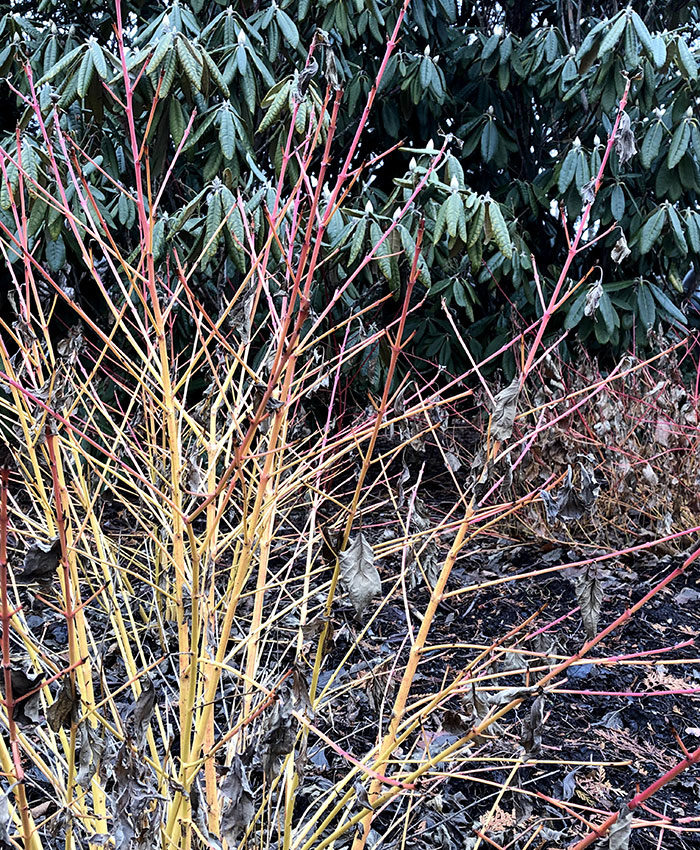
Consider plants for winter interest. As Midwestern winters bring more frequent episodes of heavy snow, ice, and winter rain, the garden can look pretty bedraggled by February. Visit your local botanic garden to note plants that are still looking good and that might work in your garden. Pay attention to sturdy perennials that remain upright and attractive and/or are providing food or shelter for birds and other wildlife. Colorful twigs and attractive bark are important too. Three top picks for reliable late winter interest in the Midwest include:
- Seven-son flower (Heptacodium miconioides, Zones 5–9). Attractive ribbons of shaggy tan-colored bark double as nesting material for songbirds.
- Arctic Sun™ redtwig dogwood (Cornus sanguinea ‘Cato’, Zones 4–8). Vibrant canes are sunny yellow at the base, transitioning to bright pink-red at the tips, highlighted by black buds.
- ‘Northwind’ switchgrass (Panicum virgatum ‘Northwind’, Zones 5–9). Tawny foliage maintains its upright vase shape long after other grasses have toppled.
Also check out these articles for more recommendations on winter interest for the Midwest:
- Midwest Late-Winter Interest
- Ornamental Bark on Deciduous Trees in the Midwest
- Weeping Conifers for the Midwest

Pay attention to seasonal houseplants. Give winter flowering houseplants like amaryllis (Hippeastrum spp. and cvs., Zones 8–10) and Christmas cactus (Zygocactus and Schlumbergera spp. and cvs., Zones 10–12) some postbloom attention. Clip off finished amaryllis flower stalks, and lightly prune Christmas cacti to shape and to keep size in check. Save pruned stems with three or four leaf paddles to propagate new plants; insert the cut stems into a moistened tray of lightweight potting soil, and water thoroughly to nestle soil around the stems. Maintain humidity by placing the cuttings under a humidity dome or inside an inflated clear plastic bag, and keep them in a warm space with only indirect light. After roots form in 6 to 8 weeks, put cuttings into individual pots, then gradually move them into brighter light. Both amaryllis and Christmas cacti appreciate a dose of a balanced, slow-release houseplant fertilizer such as Osmocote after blooming as well.

Review last year’s garden records and photographs. In addition to brightening dreary February days, revisiting last year’s photos helps us evaluate planting designs and garden moments and how to repeat or improve them in the upcoming year. You will frequently notice details that were missed while you were bustling around during the summer! Consider adopting a garden record-keeping system in the upcoming year to monitor your plant acquisitions. One easy way to do this is to punch a hole in nursery tags of new plants and string them on a ball chain or key ring. Start a new set each year to keep track of planting dates.

Sunny winter days are perfect for pruning deciduous trees, since branch structure is more visible without foliage. To being your pruning job, remove dead, diseased, and injured branches first. If you’re questioning whether a branch is really dead, scratch a little outer bark off a twig with a fingernail; a hint of green cambium underneath indicates live tissue. Leaf and flower buds are also a good place to look for signs of life. Dry, withered buds point to a branch that is dead or suffering. While looking out your windows, pay attention to ways to strategically prune branches to frame or highlight particular garden views from inside. Working with a partner can be helpful, with one person outside pruning or flagging branches for later removal while a second person calls the shots from the window.

Prepare for indoor seed starting. February is still too early to sow most seeds, but review seeding and transplanting recommendations on seed packets, and count back from your average last spring frost date to make a seeding calendar. Collect and clean flats and pots, pick up germination mix, and test grow lights and heat mats so you’re ready to go when seeding time comes.
—Erin Presley is a horticulturist at Olbrich Botanical Gardens in Madison, Wisconsin.


















Comments
Log in or create an account to post a comment.
Sign up Log in